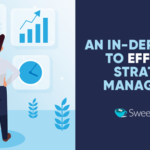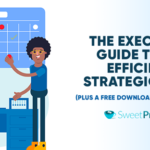Reasons Strategic Planning Processes Fail and How You Can Avoid It
Last Updated on June 14, 2021 by Owen McGab Enaohwo
Strategic planning is the identification and achievement of long-term overall aims and interests.
Unfortunately, most businesses fail to achieve their set goals when certain factors of strategic planning aren’t handled properly.
On today’s episode of the Process Breakdown Podcast with Dr. Jeremy Weisz, the guest speaker, Joan Rosal, shares seven factors that affect strategic planning processes, leadership effectiveness, progress monitoring, and onboarding new staff.
Listen to the interview
Subscribe for more business success stories
Key Resource List
- SweetProcess.com, 14-day free trial, no credit card required
- Multiply Mii
Show Notes
0:06 – Introduction
0:26 – Dr. Weisz shares the best solution that makes documenting standard operating procedures drop-dead easy, highlighting a 14-day free trial. No credit card required.
2:12 – Dr. Weisz introduces this episode’s guest, Joan Rosal, COO and founding member of MultiplyMii Staffing Solution.
2:44 – Ms. Rosal talks about MultiplyMii and what the company is all about.
2:34 – Ms. Rosal tells us how she met the founders of MultiplyMii and how she became part of their team.
4:45 – Ms. Rosal explains why strategic planning processes fail, pointing out seven factors that greatly affect results.
6:12 – Ms. Rosal talks about communication, and how it affects strategic planning.
7:46 – Ms. Rosal explains how the organization goes about planning and getting the team ready beforehand.
9:09 – Ms. Rosal talks about culture, how culture and people work hand in hand, and how company culture should be open to change and growth.
10:04 – Ms. Rosal talks about the “people component,” and how they are crucial.
11:35 – Ms. Rosal elaborates on focusing on people’s capabilities and capacities.
12:07 – Ms. Rosal talks about leadership and the effectiveness of being an active role model for the team.
13:17 – Ms. Rosal talks about success metrics, why it’s critical to monitor progress and the importance of getting regular feedback.
15:09 – Ms. Rosal explains what makes a successful placement and what makes an unsuccessful placement with hires.
17:49 – Ms. Rosal walks us through the next step after talking with the client about the culture, the process, and the job description.
18:44 – Ms. Rosal tells us what’s next after sourcing candidates for the job.
20:35 – Ms. Rosal describes important inclusions in the onboarding and training phase.
22:28 – Ms. Rosal talks about adaptability, explaining how there should always be room for improvement and adjustment, but that the goal should never be abandoned.
23:35 – Ms. Rosal talks about rewards, how it keeps teammates on the goal, highlighting the importance of celebrating milestones, recognizing people for contributions, and rewarding hard workers.
24:34 – Ms. Rosal gives examples of celebrations and rewards.
25:43 – Ms. Rosal gives examples of other acts of rewards she’s seen in other companies.
28:14 – Outro
Guest Profile

Joan Rosal is COO at MultiplyMii Metro Manila, an offshore staffing solutions company based in the Philippines. Her company is aimed at pairing up top Filipino talent with corporations around the world. She’s also highly skilled in areas such as web project management, web development, web analytics and user interface design.
Transcript of this interview
Automated Voice: Welcome to the Process Breakdown Podcast, where we talk about streamlining and scaling operations of your company, getting rid of bottlenecks, and giving your employees all the information they need to be successful at their jobs. Now, let’s get started with the show.
Dr. Jeremy Weisz: Dr. Jeremy Weisz here, host of the Process Breakdown Podcast, where we talk about streamlining and scaling operations of your company, getting rid of bottlenecks, and giving your staff everything they need to be successful at their job. Check out p… You know, Joan, I always like to mention past episodes. There was a great episode with [inaudible 00:00:43]. There’s a great episode with Carl Cox, and he talks about KPI’s. David Allen and getting things done, Michael Gerber of the E-Myth, and many more. So check those out. And before I introduce today’s guest, this episode is brought to you by SweetProcess. So if you’ve had team members ask you the same questions over and over and it may be the 10th time you spent explaining it, there’s actually a better way. There is a solution and SweetProcess is software that makes it drop dead easy to train and onboard new staff and save time with existing staff.
Dr. Jeremy Weisz: Now, I was talking with one of the founders, Owen, not only do universities, banks, hospitals, and software companies use them, but first responder government agencies use them in life or death situations to run their operations. So you can actually use SweetProcess to document all the repetitive tasks that eat up your precious time so you can focus on growing your team, empowering them. And sign up for a free 14 day trial, no credit card is required. You can go to sweetprocess.com. It’s sweet like candy, S-W-E-E-T, process.
Dr. Jeremy Weisz: I am excited to introduce today, Joan Rosal. She is the COO and founding member of MultiplyMii Staffing Solution. And before MultiplyMii, Joan has a career over 15 years working in a variety of managerial roles, running operations ranging from enterprise business process mapping to creative agencies to structuring startups, and you can check them out and MultiplyMii, that’s multiplymii.com. Joan, thanks for joining me.
Joan Rosal: Oh, thank you for that introduction, Jeremy, and it’s my pleasure, and I’m very honored for you to have me here. And I hope your followers could learn a thing or two from this session.
Dr. Jeremy Weisz: Yeah. I mean, I’m excited to dig in to this. And before we get into… We’re going to talk about strategic planning process, why it fails, how to see it through, and you have a process you use for strategic planning. But first, just tell people a little bit about MultiplyMii and what you do as a company.
Joan Rosal: Yeah. So MultiplyMii is an end-to-end off-shore staffing solution. We specialize in providing companies with the right people to ensure that their day-to-day operations are geared towards positive results and accomplishments. We support clients in identifying and sourcing for the top talents from the Philippines. We oversee their onboarding and ongoing performance management. We primarily focus on Amazon and the e-commerce businesses, but we also support different verticals.
Dr. Jeremy Weisz: And Joan, how did you meet the founders?
Joan Rosal: So funny story. The four of us actually worked in the past in an Amazon company, Amazon seller. And I actually worked there as a project manager for the digital marketing team, and then Yoni, at that time, after separating from the owners, pitched each and every of us, the other three members, to join MultiplyMii and building the company from the ground up. And upon knowing… upon learning about my past experiences, of course, he asked me to join.
Dr. Jeremy Weisz: Yeah, I talked to Yoni about it, and it was a very… he was… interesting situation of what transpired with that company and him coming on. So you could check out, there is another interview that we have done on that. So it’s pretty interesting story. But ultimately, having just a different viewpoint of the direction and culture, and then he went off and has MultiplyMii. And so, Joan, the strategic planning process, why does this fail?
Joan Rosal: Okay. So first, I just want to share, I’ve chosen this topic because it is my main responsibility to execute strategic initiatives. And why it fails. So although… Of course, with planning involved, you lay out realistic and well thought-out goals and ironclad strategies, and yet they fail because… or the goals get abandoned midway [inaudible 00:05:13] we worked or not met at the end of the year because of… For me, there’s seven factors that greatly affect the results, and those are communication, culture, people, leadership, success metrics, adaptability, and rewards. And I got that seven from my experience as either a facilitator of strategic planning, a participant, or just a regular worker that, after the planning’s done, are thrown in the results and are asked to do more or change a process, follow a new process without any explanation whatsoever.
Dr. Jeremy Weisz: So let’s walk through those individually for a second. So start with communication in the strategic planning. So what do you mean by that?
Joan Rosal: Okay. So communication is how we communicate the plans to the rest of the organization. So for me, if everyone else doesn’t buy into the idea, it’s not going to work. So everyone needs to understand the big picture and how each person in the organization will help turn that cog. People should see it as their plan and not the leadership’s plan or else it feels like it’s forced, they’re forced to do more without understanding the whys and what it means to their day-to-day lives.
Dr. Jeremy Weisz: Got it. So communication, making sure each individual knows kind of their piece and the importance of their piece so that they can take ownership and buy into the whole process.
Joan Rosal: Yeah. And aside from the initial announcement, how we communicate by means of our words and action during the full extent of the plan is important. So we have to guide the whole organization by giving them insights on how realistic and feasible are the goals, giving them updates like how far along are we on the targets, how much hustling is needed, how much more, I mean, how solid is the plan, really, and are we really in this together? [crosstalk 00:07:33].
Dr. Jeremy Weisz: Got it. That makes sense. So communication… So is this after the leadership team is like, “We need… This is a big goal, this is a big initiative for us.” And then this kind of transpires after that. Is that right?
Joan Rosal: Yep, that’s correct. So this is for the rest of the organization, but of course, before the actual planning session and how we get it with our own [inaudible 00:07:59] planning, last year was we, of course… We communicate ahead of time, like two or three weeks, so everyone would be ready. We gave out… We’ve readied reports so anything that they want to check and validate things… our accomplishments and what we could accomplish later on, would be there at the ready. We gave out additional reference materials like helpful articles. But really to get them in the zone beforehand, we provided… We asked them actually, because we’re a traction…
Dr. Jeremy Weisz: EOS.
Joan Rosal: … we’re a traction base, yeah, EOS model. So we ask everyone to read the book Traction beforehand. So that helped a lot. [crosstalk 00:08:57]
Dr. Jeremy Weisz: I’ve interviewed Gino Wickman. Yeah, it’s a great system. [crosstalk 00:08:59].
Joan Rosal: Oh, wow. That’s so awesome.
Dr. Jeremy Weisz: Yeah. So communication’s one, and you highl… I love that. So if you haven’t checked out Traction by Gino Wickman, check it out. Next is culture.
Joan Rosal: culture .
Dr. Jeremy Weisz: So talk about that part.
Joan Rosal: So culture and people actually work hand-in-hand, but with culture, developing your plan with great consideration and how you understand your culture is essential. So if your company culture or your values are not open to change or continuous improvement, then you would… you should expect resistance along the way.
Dr. Jeremy Weisz: That makes sense. So it kind of backs up into thinking about and talking about core values and hiring for those core values.
Joan Rosal: Yes. Mm-hmm (affirmative). And yeah. And as staffing solution company, it’s one of the things that we consider as a good hire if we hire based on the values instead of just skill.
Dr. Jeremy Weisz: And so you found it… So culture and then people.
Joan Rosal: People. And people… The people component works two ways. So the first is the composition of the people that contributed in the creation of your strategy. So like as part of the communication piece earlier, for them not to feel like it’s a leadership plan being shoved to them, they need to be part, that their voices should be heard. As for us, we’ve actually, aside from our department heads and our business unit heads, we’ve asked a couple of representatives from different departments to join our strategic plans by our planning sessions, as they were the ones to validate how reasonable were our asks in terms of the targets that we’re setting, the timelines that we’re setting, the things that we want to change. If it all makes sense to them, they understand, then even before the announcement, we already got people’s buy-in.
Dr. Jeremy Weisz: Got it.
Joan Rosal: And then the second is the composition of people within your organization. So that’s why it ties with culture, is like these are the people that would work day and out, and that they would really be the ones who execute these plans. We just think of them, they’re the ones who execute.
Dr. Jeremy Weisz: Yeah. I could see that, how you kind of have to go to them and go, “Here’s what we laid out. Is that…” Making sure there’s a balance between ambition and realistic, right?
Joan Rosal: Yeah. Mm-hmm (affirmative). [crosstalk 00:11:33].
Dr. Jeremy Weisz: I guess that goes in the timeline as well.
Joan Rosal: Yes. So really focusing on your people’s capabilities and your capacity. So it’s usually our failure to tap into their collective talents, assess what they can do and can’t do, we often misjudge the external environment and the response of the stakeholders.
Dr. Jeremy Weisz: So what’s next? So we have communication, culture, people…
Joan Rosal: And then leadership. So it’s always a question of how committed is your leadership in modeling the way? So are we walking the talk? So I don’t want to sound like a priest here or something, but it is true because the leaders are the role models, right? And so if people would sense that the commitment of the leadership team is lukewarm at best, then that’s the same response you’re going to get. So showing that we follow our own plan and how we operate and make decisions are all towards realizing our goals will greatly influence how everyone will respond to your strategy.
Dr. Jeremy Weisz: So you have to really embody that, whatever it is, you’re all in.
Joan Rosal: Yeah, exactly. Yeah. You’re the first one to drink the Kool-Aid.
Dr. Jeremy Weisz: Yeah. I could see if you’re, as a leader, not really excited about something, how are other people supposed to get excited about it?
Joan Rosal: Yes. That’s true.
Dr. Jeremy Weisz: So, okay. Communication, culture, people, leadership. [crosstalk 00:13:16]
Joan Rosal: Leadership.
Dr. Jeremy Weisz: What’s next?
Joan Rosal: The next one’s success metric. So I am… I’m obsessed with numbers. I am very data driven, so of course this is part of my list. It is critical to monitor our progress and to measure everything, like our outputs, our outcomes, even the unintended effects, and get regular feedback from all stakeholders. So focusing on the right metrics and sharing that with everyone is important. So with our company, we have what we call decision dashboards, and it’s comprised of all our… only metrics that matter. So we really focus… And everyone at any point in time can go to those dashboards and see how much we need to work on and possibly what we need to tweak. Also, knowing how to measure and how to validate this success metrics is key because even if you hit that, again, depending on your culture and the people within your organization, there’s always going to be doubts. So they need to understand how you… what’s the criteria for saying it’s a success or failure. Right?
Dr. Jeremy Weisz: I want to go a little bit deeper in the success metrics piece because we were talking before we hit record, and you create these dashboards. And one of the things that you look at as an important metric is a successful placement, right?
Joan Rosal: Yeah.
Dr. Jeremy Weisz: So talk about what makes a successful placement and what you’ve found makes a not successful placement for people out there who are looking to hire and onboard staff.
Joan Rosal: Yeah. But just to quickly, correct. So I don’t think the dashboard. It’s actually a very awesome guy in our company named [inaudible 00:15:16]. So I just help direct and tell them [inaudible 00:15:20] what each dashboard sh… what story should each dashboard say and how we’re going to use these metrics in the business. But yeah. But answering your question about our success metrics for successful hires. So one is… One is the length, of course, like retention. Of course, in the past, you can’t have everything perfectly, so there would be attritions that would happen within the onboarding period. And our onboarding period, it takes about three months because you want to make sure that we account for the learning curve. And so if people… We call the people that we staff the company’s multipliers. So if they get attrited within that onboarding period, then it’s not a successful hire.
Joan Rosal: Two… So we have temp checks in place to make sure that we have the correct fit of people. So that happens after, immediately after training, the training period, and then two other performance reviews. And then for the… Upon the decision making, and I should have started with this, when the client decides to hire someone, it’s successful because it ticks all the boxes. So before we started sourcing, we actually have a sourcing kickoff call [inaudible 00:16:56] with the clients to really understand their requirements. So we have tick boxes in our system to see if each candidate has successfully… would have that on their scale, for example, number of experience, and include… that includes the culture fit. So we ask clients for they’re hiring and firing characteristics. And so we put a score. We have a scorecard for each candidate so that we can tell how successful they’re going to be way each of the placements.
Dr. Jeremy Weisz: Yeah. So walk me through the process a little bit because it’s interesting for MultiplyMii. So you’ll have a call assessing needs. You’ll have a call with the client to talk about the culture, the process, what the job is, all of that. What’s next in the process?
Joan Rosal: So what’s next is we finalize the job description based on the discussion, the discovery discussion with the client, for them to approve. And then that’s the only time we started sourcing. And we actually have an active pool. We have a pool of candidates at the ready. So if we have… We could endorse candidates as soon as possible. Or if it’s very complex, a complex role, then it takes a couple… of course, longer time. But yeah, we make sure that we follow the requirements.
Dr. Jeremy Weisz: Got it. So then you go out to the pool of candidates that you have or outside of that and you source candidates. And then what happens after that?
Joan Rosal: Mm-hmm (affirmative). And then… So we follow the process. So as part of the call as well, if we’re going to follow the usual thing of just the set of interviews or if the clients would require additional tests or additional layers of interview before they decide on who they want to go with. Once they’ve made their decision, then that person is off to onboarding. And for new clients, we actually have an onboarding prep call so they know what the process is even before we start that kickoff with the multiplier. So we know they’re invested. They understand like how long it’s going to take, what’s required of them, what their part is, what their responsibility is as well on those three months during the onboarding period. And then once they graduate, then they’re off to the operational [inaudible 00:19:45]. they’re assigned an account manager, and then they go to the regular routine. But we don’t move people to operational without a working scorecard because it’s very important for us to, of course, make sure that they are performing at their best once assigned to the client.
Dr. Jeremy Weisz: Yeah. Joan, talk about what’s important in the onboarding and training part to include because probably, I imagine with anything, even with the client, that onboarding phase is critical. You’re kind of in this excited phase and you don’t want either party to drop the ball. What’s something to make sure to include when you are starting the training and onboarding with the new staff member?
Joan Rosal: Yeah. So we start on the process, like I said. We have a prep call, just with the client alone, to get… to make sure that they’re invested with the whole onboarding activities before we schedule a call with the client and the multiplier. So everyone’s aware of all… everything that’s going to happen and what their responsibilities, with what their role is during that onboarding. And then we have onboarding managers, like that’s purely their role, to make sure that the whole onboarding process would run smoothly. And beforehand, all of the schedules would be… all the meetings would be scheduled, of course, because we have two review sessions. And then, of course, we always get feedback from the client, temp checks to make sure everything’s okay. If there’s anything that they feel are they’ll off, then our onboarding managers would have the coaching sessions with the multipliers and try to correct.
Dr. Jeremy Weisz: There’s a lot of support around this process, it seems like.
Joan Rosal: Yes. [inaudible 00:21:54] the three months is really very hand-holding for both the client and the multiplier, especially if these are new clients. But we do have clients who are in… they already have a team of multipliers with us. And so they’ve memorized the onboarding, but they still go through it [crosstalk 00:22:17].
Dr. Jeremy Weisz: It makes it easier.
Joan Rosal: It’s easier for them, but they still go through the whole process because they believe in it. Mm-hmm (affirmative).
Dr. Jeremy Weisz: So we have communication, culture, people, leadership, success metrics. What’s the next one?
Joan Rosal: The next one is adaptive… Sorry, adaptability. Because even the best conceived plan requires adjustments along the way, right? So once you have your success metrics, your system of reporting, and all that, then we keep tabs in your process, sorry, your progress. And then it would help guide you to identify flags on how and when or where to tweak the plan. So there should always be room for improvement, room for change, but as long as we always keep the goal and adjust the plan and not the other way around.
Dr. Jeremy Weisz: Yeah. I’m sure within a plan, people hit snags or roadblocks, and you don’t just want to ditch or give up on the plan. You just want to figure out… If you have that main goal in mind of what you want to accomplish, you just kind of have to see your way around it.
Joan Rosal: Yeah. Mm-hmm (affirmative). So just small, small tweaks will do.
Dr. Jeremy Weisz: Yeah. So adaptability, and what’s the seventh?
Joan Rosal: So the last one is rewards. So it’s like what would it take to keep people focused on the goal? Right? What would make them follow the game plan? So even if your company is composed of go-getters and results-driven employees, it would always boil down later on to the same question of what’s in it for me? And this may be perceived as a negative, but we could use it to our advantage so that we in turn would not be creating greedy robots. So yeah. Milestones should be set to celebrate our progress with everyone in the company. People should be recognized for contributions, and rewards should be given to the ones that go above and beyond.
Dr. Jeremy Weisz: So what are some examples of celebrations and rewards?
Joan Rosal: So with our company, we have, since we’re following Traction… So we have quarterly rocks, and then immediately after the rocks review, we would have a town hall, so it’s at an all hands meeting, so that we could report our progress and we can celebrate the little wins, the victories, what we’ve accomplished in that quarter. And then we recognize people who are the MVPs for the quarter, and then we allocate rewards. So either like in cash and kind or anything, be it small or big. But they feel that their effort is recognized, and they feel that the importance of working with a team following and believing in the plan and the goals, right?
Dr. Jeremy Weisz: Have you seen anyone outside, not including your organization, other outside ones, any creative celebrations or rewards that you’ve observed?
Joan Rosal: We’re… Since we’re… We’re actually a remote company, so we can do this as much as I want to. With the old companies I work with, celebrations usually mean drinking in bars or giving out vouchers for relaxation, for example, spas and wellness programs and things like that. Mm-hmm (affirmative).
Dr. Jeremy Weisz: Yeah. I like that. Yeah, I’ve seen some organizations, yeah, bring in… Like, if they’re in-person, bring in like a massage therapist or something, and everyone just takes a break and gets a short massage or something like that. So this is… Joan, first of all, thank you. And I could see how, if people miss a step in here, how the strategic planning process could fail and how it doesn’t get seen through. And I really appreciate your time walking us through that. And just to summarize with the strategic planning process, it’s the communication, the culture, the people, leadership, success metrics, the adaptability, and the rewards kind of completes the whole picture. And I want to-
Joan Rosal: There’s a bonus.
Dr. Jeremy Weisz: Yeah, go ahead. Give me the bonus.
Joan Rosal: Like how to see it through. So aside from ticking all the seven boxes correctly, what helps, from my experience, is establishing clear accountability for each deliverable and action plans to ensure movement.
Dr. Jeremy Weisz: I love it. Yeah. And so Joan, I want to point everyone to MultiplyMii, multiplymii.com, to check out more about the company. Are there any other places we should point people towards online? Or is that the best place?
Joan Rosal: Yeah. That’s the best place. Yeah. Mm-hmm (affirmative). So the website. Yoni also has a podcast if you guys want to listen to it. It’s Successful Scales. Aside from MultiplyMii, we actually have another company. It’s called Escala, and it’s our consulting service arm.
Dr. Jeremy Weisz: So you could check out also Escala, it’s E-S-C-A-L-A, as well. So Joan, thank you so much. Everyone, check out MultiplyMii. Check out more episodes of the podcast. Check out SweetProcess. And thanks everyone. Thanks, Joan.
Joan Rosal: Thank you very much. Bye.
Automated Voice: Thanks for listening to the Process Breakdown Podcast. Before you go, quick question. Do you want a tool that makes it easy to document processes, procedures, and/or policies for your company so that your employees have all the information they need to be successful at their job? If yes, sign up for a free 14-day trial of SweetProcess. No credit card is required to sign up. Go to sweetprocess.com, sweet like candy and process like process.com. Go now to sweetprocess.com and sign up for your risk-free 14-day trial.
Owen: Hi, this is Owen to CEO and co-founder here at SweetProcess. If you’ve enjoy listening to this podcast interview, actually, you know what I want you to do? Go ahead and leave us a five-star review on iTunes, that way we get more people aware of the good stuff that you get here on this podcast. Again, go on to iTunes and leave us a five-star review. We look forward to reading your review. Have a good day.











Leave a Reply